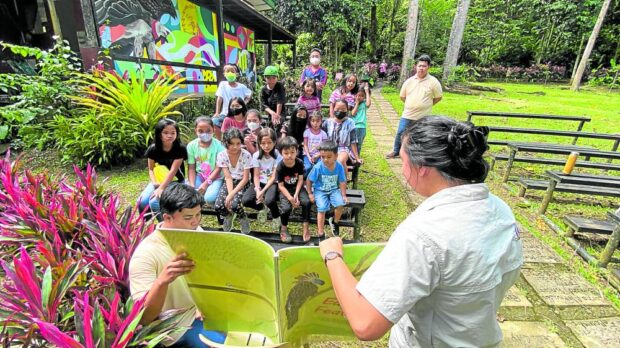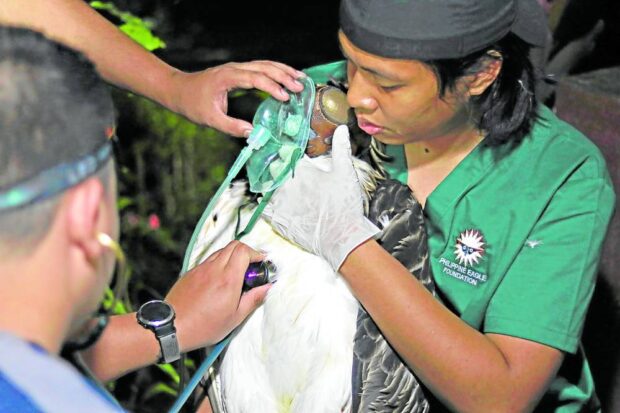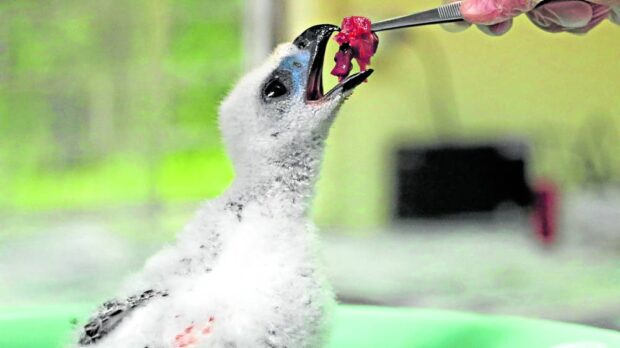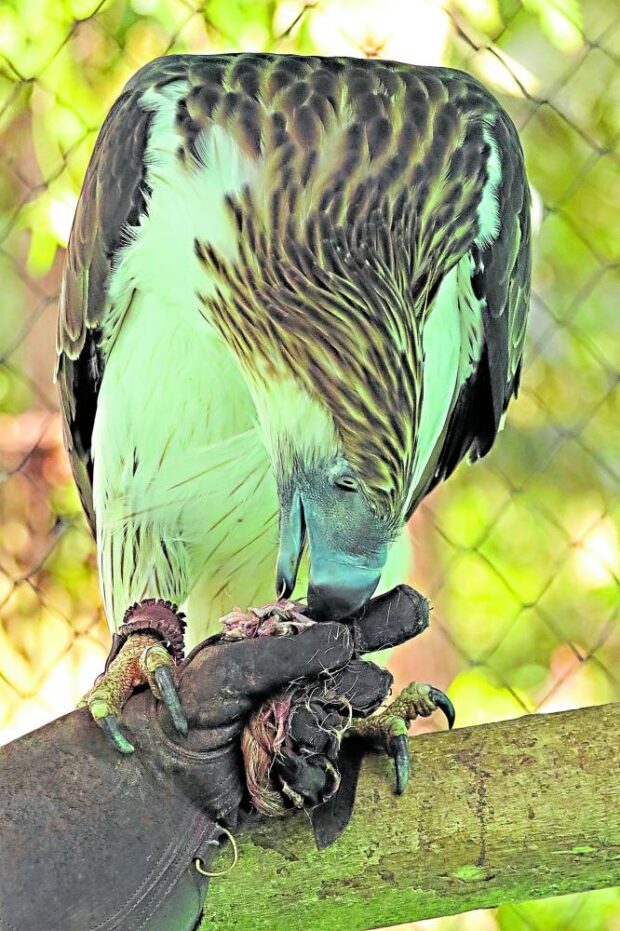Davao a haven for eagle conservation

CONSERVATION EDUCATION PEF staff teaches children the importance of environmental conservation and protection while on a visit at the Philippine Eagle Center in Barangay Malagos. —Photos by Erwin M. Mascariñas
DAVAO CITY—Amid heavy rains last January, workers of the Philippine Eagle Foundation (PEF) braved the muddy trail toward a forested mountain in Barangay Eden to bring construction materials.
The bags of cement, hollow blocks, long metal pipes, cyclone wires, lumbers, roofing sheets, nails, iron bars, coarse sand and crushed stone, among many others, are intended to build another sanctuary for the captive Philippine Eagles that the PEF are currently taking care of in its 8-hectare conservation facility in Barangay Malagos.
At the mountain in Eden, PEF is rushing the establishment of the Philippine Eagle Conservation Breeding Sanctuary (PECBS) as part of its strategy to increase the chances of rescued and captive-bred raptors surviving in the wild after being released from human care.
Hence, almost every day since January, at least 20 Bagobo Tagabawa forest guards manually haul construction materials from a downhill road to the construction site, walking 500 meters uphill as the access road is not yet done.
With a temporary power connection established, two generators now run for welding works. Overall, two full-time PEF staff supervise the work of setting up the PECBS.
“Rains and frequent fog are also getting in the way of welding and construction works. But we have to push on despite these challenges,” Dr. Jayson Ibañez, PEF director for research and conservation, told the Inquirer.
According to PEF executive director Dennis Salvador, they have long planned and advocated for the transfer of breeding eagles to a new site where they will be safer from the threats of diseases and distractions given the fast-changing landscape around its Malagos facility.

ANNUAL ROUTINE A PEF biologist holds the Philippine Eagle while others administer oxygen and check the bird’s heart rate and breathing during the annual eagle checkup at the Malagos facility.
Pioneering work
The Philippine Eagle Center was built in 1987, both as a captive-breeding facility and nature park to educate people about the urgent need to conserve the critically endangered national bird and other species. It grew out of a small rescue center in Barangay Baracatan in the 1970s intended to help injured birds.
The Malagos facility, the only one of its kind throughout the world, has since pioneered captive breeding of the rare raptors, and since 1992 had successfully produced 28 eagles, and rehabilitated scores more that were rescued from the communities in Mindanao.
Its operation ran through grants, PEF also had adopters, usually from the business community, who provided support for the care of each eagle bred in captivity.
Back in 1987, Malagos still had lush greenery and was secluded from human activities. But today, urban and agricultural expansion has been catching up on the facility that its woodland buffer has thinned out hence, noise level is already a concern.
There are also corn and banana farms that use harmful pesticides, and game fowl and poultry farms from where diseases that could infect birds could propagate and develop.
Ibañez had said that, among others, they feared the raptors could be afflicted by avian flu, Newcastle disease and trichomoniasis that is why the transfer is critical to the future of the eagle conservation effort.
The latest estimate is that there are only 392 pairs of Philippine Eagles in the wild. The PEF’s goal is to make the captive-bred raptors easily adapt to the conditions of the wild when eventually released, which requires that they be raised in seclusion and with minimum human interaction. And that can be achieved in the new sanctuary in Eden as it will not be open to the public, unlike the facility in Malagos.

MEAL TIME A 34-day-old Pinsker’s Hawk-eagle, also known as Mindanao hawk-eagle (Nisaetus pinskeri), is fed with rabbit and goat meat in this April 17, 2018 photo inside the Malagos facility.
Sanctuary
The Eden facility sits over 1,000 meters above sea level, and is part of the 105-hectare tourism reservation area of the Davao City government, at the foot of Mount Apo, which is a natural nesting habitat of the raptors.
Salvador said the administration of Mayor Sebastian Duterte had conceded for PEF’s use 13.46 hectares of which 8.16 hectares will be maintained as a buffer zone of natural forest.
Part of the city government’s commitment to the development of the new eagle sanctuary is the construction of an access road to the site.
So far, the PECBS now has a completed house for eagle keepers, six holding cages, and food preparation area, while work is ongoing for the breeding chambers. PEF is looking forward to transferring breeding pairs there within the year.
The immediate future of eagle conservation now rests on this modern-day “Noah’s Ark” atop Davao’s Eden.

A Philippine Eagle is hand-fed with rabbit meat inside its enclosure.
